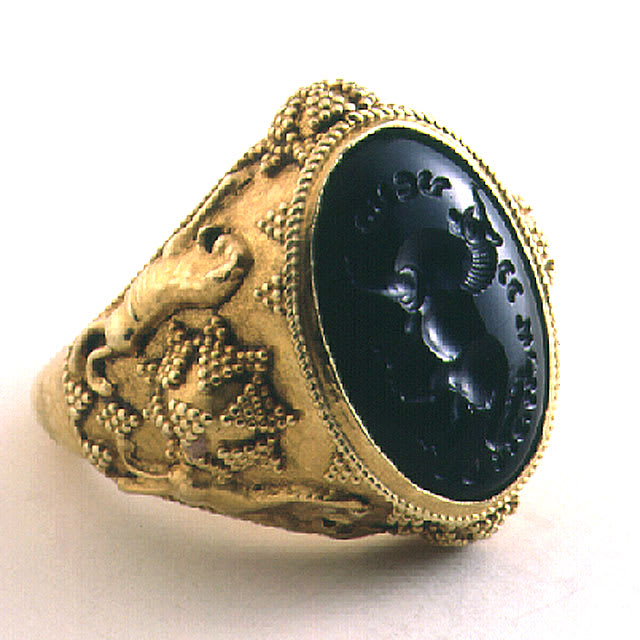Onyx Intaglio Ring Depicting a Bull
Onyx, Gold
FJ.6333
This Intaglio is Set in a 22 Karat Gold Rin The art of glyptics, or carving images on colored precious stones, is probably one of the oldest known to humanity....
This Intaglio is Set in a 22 Karat Gold Rin
The art of glyptics, or carving images on colored precious stones, is probably one of the oldest known to humanity. Intaglios, gems with an incised design, were made as early as the fourth and third millennia B.C. in Mesopotamia and the Aegean Islands. They exhibit a virtuosity of execution that suggests an old and stable tradition rooted in the earliest centuries. The tools required for carving gems were simple: a wheel with a belt-drive and a set of drills. Abrasives were necessary since the minerals used were too hard for a metal edge. A special difficulty of engraving intaglios, aside from their miniature size, was that the master had to work with a mirror-image in mind.
A boldly engraved bull dominates this unique intaglio. Most probably the artist, like his predecessors in the 18th century, studied ancient sculpture, coins and painting for inspiration. The bull does in fact resemble those found painted on the walls of the palace of Minos on Knossos. Its head is quite small in comparison with the body, the chest extended and full, the legs positioned to give the impression of movement. Surrounding the bull is an enigmatic script which appears like leaves blowing in the wind, as if the bull is strolling across an open field. The ring itself is highly ornate, including four finely modeled lions and four globes covered in pellets. Both ring and intaglio combine to create an effect of subtle opulence, with a touch of mystery.
The art of glyptics, or carving images on colored precious stones, is probably one of the oldest known to humanity. Intaglios, gems with an incised design, were made as early as the fourth and third millennia B.C. in Mesopotamia and the Aegean Islands. They exhibit a virtuosity of execution that suggests an old and stable tradition rooted in the earliest centuries. The tools required for carving gems were simple: a wheel with a belt-drive and a set of drills. Abrasives were necessary since the minerals used were too hard for a metal edge. A special difficulty of engraving intaglios, aside from their miniature size, was that the master had to work with a mirror-image in mind.
A boldly engraved bull dominates this unique intaglio. Most probably the artist, like his predecessors in the 18th century, studied ancient sculpture, coins and painting for inspiration. The bull does in fact resemble those found painted on the walls of the palace of Minos on Knossos. Its head is quite small in comparison with the body, the chest extended and full, the legs positioned to give the impression of movement. Surrounding the bull is an enigmatic script which appears like leaves blowing in the wind, as if the bull is strolling across an open field. The ring itself is highly ornate, including four finely modeled lions and four globes covered in pellets. Both ring and intaglio combine to create an effect of subtle opulence, with a touch of mystery.
